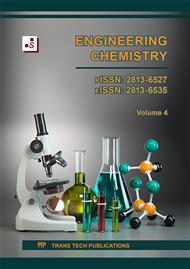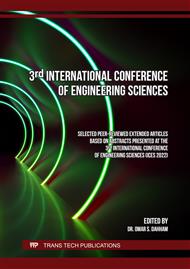[1]
W. G. Ying, The investigation of blending properties of biodiesel and diesel fuel, J Jiangsu Polytech. Univ. 15(2003).
Google Scholar
[2]
A. Subrata, S.Karmakar and M.Souti, Properties of various plants and animals feedstocks for biodiesel production, Biores. Tec. (2010) 7201–7210.
DOI: 10.1016/j.biortech.2010.04.079
Google Scholar
[3]
A.M. Namasivayam, T. Korakianitis and R.J. Crookes, Biodiesel, emulsified biodiesel and dimethyl ether as pilot fuels for natural gas fuelled engines, Appl. Ener. 87(2010) 769–78.
DOI: 10.1016/j.apenergy.2009.09.014
Google Scholar
[4]
L.C. Meher, D.V. Sagar and S.N. Naik, Technical aspects of biodiesel production by transesterification—a review, Rene. and Sustain. Ener. Rev. 10(2006) 248–268.
Google Scholar
[5]
K. Noiroj, P. Intarapong, A. Luengnaruemitchai and S. J In, A comparative study of KOH/Al2O3 and KOH/NaY catalysts for biodiesel production via transesterification from palm oil, Renew. Ener. 34(2009) 1145-1150.
DOI: 10.1016/j.renene.2008.06.015
Google Scholar
[6]
F. Ma and M.A. Hanna, Biodiesel production: a review, Bioresour. Technol. 70(1999) 1-15.
Google Scholar
[7]
F.A. Dawodu, O. Ayodele, J. Xin, S. Zhang and D. Yan, Effective conversion of non-edible oil with high free fatty acid into biodiesel by sulphonated carbon catalyst, Appl. Energy 114(2014)819-826.
DOI: 10.1016/j.apenergy.2013.10.004
Google Scholar
[8]
L.J. Konwar, J. Boro and D. Deka, Review on latest developments in biodiesel production using carbon-based catalysts, Renew. Sustain. Ener. Rev. 29(2014)546–564.
DOI: 10.1016/j.rser.2013.09.003
Google Scholar
[9]
Q. Shu, Z. Nawaz, J. Gao, Y. Liao, Q. Zhang, D. Wang and J.Wang, Synthesis of biodiesel from a model waste oil feedstock using a carbon-based solid acid catalyst: Reaction and separation, Bioresour. Technol. 101(2010) 5374–5384.
DOI: 10.1016/j.biortech.2010.02.050
Google Scholar
[10]
M.L. Savaliya, M.S. Bhakhar, and B.Z. Dholakiya, Cutting Cost Technology for the Preparation of Biodiesel Using Environmentally Benign and Cheaper Catalyst, Catal. Lett. 146 (2016) 2313–2323.
DOI: 10.1007/s10562-016-1861-z
Google Scholar
[11]
A.K. Singh and S.D. Fernando, Transesterification of Soybean Oil Using Heterogeneous Catalysts, Energy & Fuels 22(2008) 2067–2069.
DOI: 10.1021/ef800072z
Google Scholar
[12]
W. Xie, X. Huang and H. Li, Soybean oil methyl esters preparation using NaX zeolites loaded with KOH as a heterogeneous catalyst, Bioresour. Technol. 98(2007) 936–939.
DOI: 10.1016/j.biortech.2006.04.003
Google Scholar
[13]
R. Q. Sabah and M. F. Abdul Jabbar, Esterification of Lauric Acid with Ethanol Using Zirconium Oxide as Heterogeneous Catalyst, Petrol. and Coal J. 62(3)(2020) 799-803.
Google Scholar
[14]
K. D. Pandiangan, W. Si. Ilim, H. Satria and N. Jamarun, Catalytic Performance of CaO/SiO2 Prepared from Local Limestone Industry and Rice Husk Silica, Journal of Pure and Applied. Chemistry Research 8(2) (2019) 170-178.
DOI: 10.21776/ub.jpacr.2019.008.02.459
Google Scholar
[15]
N.A. M. Shohaimi and F. N. S. Marodzi, Transesterification of Waste Cooking Oil in Biodiesel Production Utilizing CaO/Al2O3 Heterogeneous Catalyst, Malaysian Journal of Analytical Sciences 22 (1)(2018) 157-165.
DOI: 10.17576/mjas-2018-2201-20
Google Scholar
[16]
V. Sisca, S. Zilfa and N. Jamarun, Biodiesel Production from Waste Cooking Oil Using Catalyst Calcium Oxide Derived of Limestone Lintau Buo, Archives of Pharmacy Practice 11(3)(2020) 8-14.
DOI: 10.22146/ijc.64675
Google Scholar
[17]
F. Yasar, Biodiesel production via waste eggshell as a low-cost heterogeneous catalyst: its effects on some critical fuel properties and comparison with CaO, Fuel 255(2019) 115828.
DOI: 10.1016/j.fuel.2019.115828
Google Scholar



